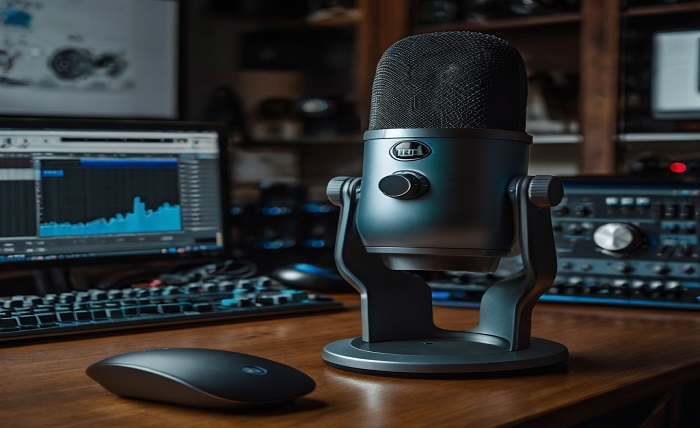Introduction
Musicians, streamers, podcasters, and content producers love the Blue Yeti microphone. Due to its adaptability and studio-caliber sound, it is a dependable option for all audio requirements. However, knowing the optimal Blue Yeti settings may greatly improve the quality of your audio. In this article, we’ll review the many options and tweaks to optimize your Blue Yeti’s performance.
Read More About: yeti cooler
Understanding the Blue Yeti’s Key Features

Gain control, plug-and-play functionality, and numerous polar patterns are just a few of the remarkable features that make the Blue Yeti stand out. You must comprehend how each feature functions to realize its full potential. The polar pattern selector lets you pick between cardioid, omnidirectional, bidirectional, and stereo modes, while the gain knob lets you change the microphone’s sensitivity. To customize your microphone to your unique requirements, becoming familiar with these Blue Yeti options is essential.
Choosing the Right Polar Pattern for Your Needs
The Blue Yeti’s four polar patterns are among its most distinguishing characteristics:
Cardioid Mode: Perfect for voiceovers, gaming, and solo podcasts.
Omnidirectional Mode: Ideal for group conversations or conference calls.
Bidirectional Mode: Ideal for duets or interviews.
Stereo Mode: Ideal for ASMR and music recordings.
Choosing the appropriate polar pattern reduces unwanted noise and guarantees the best possible sound recording. You can significantly enhance your recordings by experimenting with these Blue Yeti settings.
Adjusting Gain Control for Clarity
A crucial component of your Blue Yeti settings is gain. While too little gain renders your voice inaudible, too much gain distorts the audio. Set the gain knob halfway at first, then gradually modify it according to your surroundings. To prevent clipping, which shows up on recording software as red peaks, always keep an eye on your levels. A somewhat greater gain might be suitable in quieter settings, but lower it in louder areas to cut down on background noise.
Optimizing the Blue Yeti for Streaming
Clear audio is essential for streamers to interact with their viewers. How to configure your Blue Yeti to stream:
To concentrate on your voice, use Cardioid Mode.
Place the microphone between 6 and 12 inches from your mouth.
To reduce plosive noises, use a foam windscreen or pop filter.
Make sure your Blue Yeti settings are optimized for balanced audio by adjusting the gain and monitor levels in your streaming software.
Perfecting the Blue Yeti for Podcasts and Voiceovers
Podcasts require a warm, professional tone in their audio. To go there, follow these steps:
Use Bidirectional Mode for interviews or Cardioid Mode for one-on-one sessions.
To lessen plosive sounds, place the Blue Yeti at a slight slant.
To get rid of echoes, record in a sound-treated space or use acoustic foam.
To discover the ideal balance for your voice, experiment with different Blue Yeti settings, including gain and EQ tweaks.
Recording Music with the Blue Yeti
Additionally, the Blue Yeti is a great option for musicians. Recording acoustic instruments, vocals, or even ASMR:
For a spacious, engrossing soundstage, choose Stereo Mode.
For low-frequency emphasis, carefully position the microphone while taking the proximity effect into account.
In particular, while recording loud instruments, reduce the gain to prevent distortion.
Depending on your setup and preferred sound, try out various polar patterns. The correct Blue Yeti settings can significantly impact your music production.
Using Software to Enhance Your Blue Yeti Settings
The Blue Yeti’s hardware settings are important, but you can also fine-tune your sound with the software options.
Audacity: is a free program that provides compression, EQ, and noise removal.
Adobe Audition: More sophisticated tools for improving and cleaning up audio.
With filters: to enhance sound quality, OBS Studio is an excellent choice for live streaming.
DAWs (Digital Audio Workstations): You can use sophisticated tools to edit recordings with programs like FL Studio or GarageBand.
To get results that are on par with those of a professional, combine your Blue Yeti settings with software settings.
Conclusion
The secret to creating high-quality audio for voiceovers, music, podcasts, and streaming is to become proficient with your Blue Yeti settings. You can produce recordings that are clear and professional by being aware of the microphone’s capabilities, selecting the appropriate polar pattern, and adjusting the gain control. To take your audio to the next level, combine these settings with software improvements.
Read More About: technewztop
FAQs
Which Blue Yeti settings work best for streaming?
Put the microphone 6–12 inches away, use Cardioid Mode, then apply a pop filter. To balance your voice without recording background noise, adjust the gain.
How can I use Blue Yeti without background noise?
Record in a quiet area, select Cardioid Mode and reduce the gain. Software for noise reduction can also be useful.
For podcasts, which polar pattern should I use?
Bidirectional Mode is ideal for interviews, whereas Cardioid Mode is better for solo podcasts.
Which program is most compatible with Blue Yeti?
OBS Studio is ideal for streaming, while Audacity and Adobe Audition are excellent for editing. Each successfully improves your Blue Yeti settings.
Is it possible to capture music with the Blue Yeti?
Indeed! For the best results, experiment with gain and polar patterns and use Stereo Mode for a broader soundstage.

